Buinsa Temple (Daegu) (부인사(대구))
15.5Km 2024-02-23
967-28 Palgongsan-ro, Dong-gu, Daegu
Buinsa Temple is a temple nestled on the southern slopes of Palgongsan Mountain, with a deep historical connection to Queen Seondeok of Silla (580–647). The temple is renowned for preserving the woodblocks of the First Tripitaka Koreana, a collection of Buddhist scriptures carved in the 11th century. The current Buinsa Temple encompasses significant structures, including Daeungjeon Hall, Queen Seondeok's Memorial Hall, and Samseonggak Shrine. Visitors have the opportunity to appreciate the scenic beauty of nature while exploring the cultural and architectural heritage from the Silla and Goryeo periods.
Palgongsan National Park (Pagyesa Temple District) (팔공산국립공원(파계사지구))
15.5Km 2025-04-08
741 Pagye-ro, Dong-gu, Daegu
+82-53-939-0080
Palgongsan National Park is located close to Palgongsan Mountain, one of the larger mountains in the Taebaek Mountain Range. Palgongsan Mountain is located 20 kilometers northeast from downtown Daegu, where Nakdonggang River and Geumhogang River meet. The mountain has three peaks in a row: Birobong Peak in the center and Dongbong Peak (aka Mitabong, 1,155 m) and Seobong Peak (aka Samseongbong, 1,150 m) on each side.
The park is within the administrative district of Dong-gu, Daegu and has four towns along its border including Yeongcheon-si, Gyeongsan-si, and Chilgok-gun. A number of Buddhist temples including Donghwasa Temple, the headquarters of the 9th Buddhist Parish, are located in the area.
The park has numerous rocks and valleys and is carpeted with azaleas in the spring. In autumn, many visitors flock to the park to admire the fall foliage on the trees lining the 16.3 kilometer-long roadway that runs through the park. With vibrant green leaves in spring and a delicate snowscape in the winter, Palgongsan Mountain is an attractive destination for visitors throughout the year.
Daegu Safety Theme Park (대구시민안전테마파크)
15.7Km 2021-07-08
1155, Palgongsan-ro, Dong-gu, Daegu
+82-53-980-7770
Daegu Safety Theme Park was established to provide citizens with education on safety measures in an emergency situation. The theme park has experience stations set up to demonstrate accidents one can encounter in their everyday life and provides an opportunity to exercise simulated safety drills. Noteworthy exhibition halls that provide practical and useful safety information include the Subway Safety Exhibition, Mountain Safety Exhibition, and Earthquake Safety Exhibition. All of the facilities throughout the park, including the exhibition halls and the safety education theater, are designed to emphasize the importance of safety.
Sanchae Restaurant (산채식당)
15.7Km 2024-02-28
72, Palgongsan-ro 185-gil, Dong-gu, Daegu
053-985-4082
Sanchae Restaurant is a wild vegetable Korean restaurant situated at the entrance of Palgongsan Cable Car. Since its opening in 1995, the restaurant has passed onto its second generation, maintaining the authentic flavors that have defined its success. With a commitment to recreating traditional homemade meals, Sanchae Restaurant uses self-cultivated vegetables, perilla seeds, garlic, chili pepper powder, and homemade fermented condiments. Among its signature dishes, the sannamul bibimbap (wild vegetable bibimbap) stands out, showcasing a delightful blend of seven namuls (salad) seasoned with a savory soy sauce.
Mt. Palgong Hot Spring Tourist Hotel (팔공산온천관광호텔(온천))
15.9Km 2024-02-28
11 Palgongsan-ro 185-gil, Dong-gu, Daegu
Mt. Palgong Hot Spring Tourist Hotel is nestled near Birobong Peak of Palgongsan Mountain. It features a hot spring bath with sodium chloride alkaline water (pH 8.0), sourced from 687 meters below the granite surface of a nearby valley. The spring water, at a temperature of 28.9 ℃, is renowned for its properties that soothe the skin, enhance blood circulation, and relieve fatigue. The facility includes hot and cold baths, jet benches for water massages, a sauna, and open-air baths. Additionally, the surrounding Palgongsan Mountain area boasts numerous tourist attractions, including Donghwasa Temple, a cable car, and various hiking trails.
Palgongsan National Park (Donghwasa Temple District) (팔공산국립공원(동화사지구))
16.0Km 2025-04-08
1 Donghwasa 1-gil, Dong-gu, Daegu
Palgongsan National Park is located close to Palgongsan Mountain, one of the larger mountains in the Taebaek Mountain Range. Palgongsan Mountain is located 20 kilometers northeast from downtown Daegu, where the Nakdonggang and Geumhogang Rivers meet. The mountain has three peaks in a row: Birobong Peak (1192.3 meters) in the center and Dongbong (aka ‘Mitabong,’ 1,155 meters) and Seobong (aka ‘Samseongbong,’ 1,150 meters) on each side.
The park is within the administrative district of Dong-gu, with Daegu and four towns along its border, including Yeongcheon-si, Gyeongsan-si, and Chilgok-gun. A number of Buddhist temples including Donghwasa, the headquarters of the 9th Buddhist Parish, are located in the area.
The park has numerous rocks and valleys and is carpeted with azaleas in the spring. In the autumn many visitors flock to the park to admire the fall leaves on the trees lining the 16.3-kilometer-long roadway that runs through the park. With vibrant green leaves in spring and a delicate snowscape in the winter, Palgongsan Mountain is an attractive destination for visitors throughout the year.
Palgongsan Nature Park (Gatbawi District) (팔공산자연공원(갓바위지구))
16.0Km 2024-02-29
6-1 Palgongsan-ro 199-gil, Dong-gu, Daegu
+82-53-939-0080
Palgongsan Nature Park, located in the Taebaek Mountain Range, features three peaks: Birobong Peak (1,192m), Yeombulbong Peak (1,042m), and Seobong Peak (1,150m). This mountain area boasts stunning rock formations and valleys. At an elevation of 852 meters on Gwanbong Peak, the Gatbawi Rock is renowned for fulfilling wishes. Other attractions include Donghwasa Temple, the Palgongsan Cable Car, and the Donghwasa Tourist Complex.
Palgongsan Cable Car (팔공산 케이블카)
16.0Km 2025-03-26
51 Palgongsan-ro 185-gil, Dong-gu, Daegu
Palgongsan Cable Car takes visitors a ride on an ascending slope, offering both thrill and beautiful views. The cable car's landing platform is at the top of Sinnimbong Peak of Palgongsan Mountain. This peak is considered one of the most famous prayer spots, together with the ritual alter on Birobong Peak and the Buddha statue on the eastern Gatbawi Rock.
St. Mary's Pine Forest Village (성모솔숲마을)
16.1Km 2024-02-08
166 Songnae-gil, Gakbuk-myeon, Cheongdo-gun, Gyeongsangbuk-do
St. Mary's Pine Forest Village, a serene retreat house under the Catholic Archdiocese of Daegu, was initially established as a haven for the sick and those seeking spiritual retreats. However, it is now open to all, regardless of their reason for visiting. A mass is celebrated at eleven every morning in the church, welcoming both Catholics and non-Catholics alike. Visitors who are not of the Catholic faith are also encouraged to explore the church, or enjoy a peaceful stroll through the surrounding pine forest. The village comprises several facilities, including the Pine Forest Church, the Way of the Cross, a restaurant, a café, and the Yedam Gallery, which is located within the café.
Daegu Donghwasa Temple (동화사(대구))
16.4Km 2023-11-14
1 Donghwasa 1-gil, Dong-gu, Daegu
Donghwasa Temple is located on the south side of Palgongsan Mountain, about 22 km northeast of Daegu. It was built by Monk Geukdal in the 15th year of King Soji’s reign (AD 493). The original name of the temple was Yugasa Temple, but Simjiwangsa rebuilt the temple under King Heungdeok (r. AD 826-836) and named it Donghwasa Temple, which means "the paulownia tree blooms even in winter," in reference to the blooming trees around the temple. Most of the present temple buildings were constructed between 1723 and 1732.
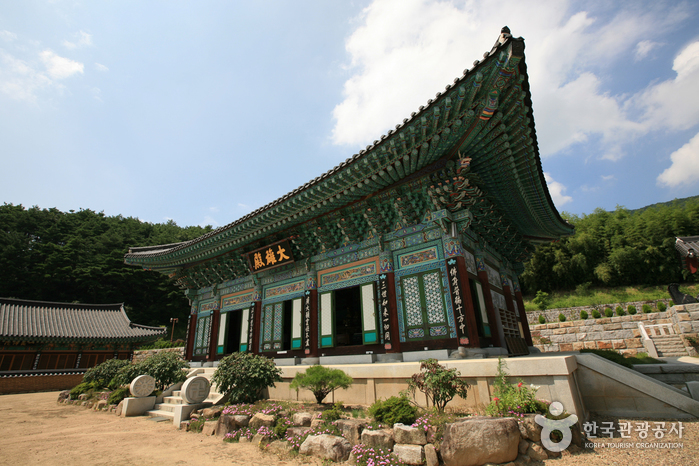
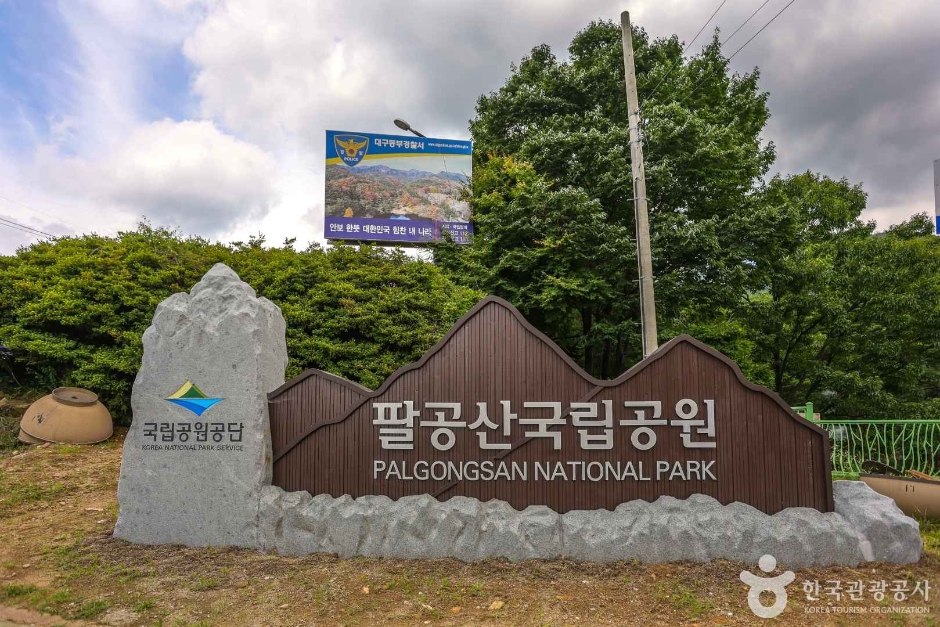
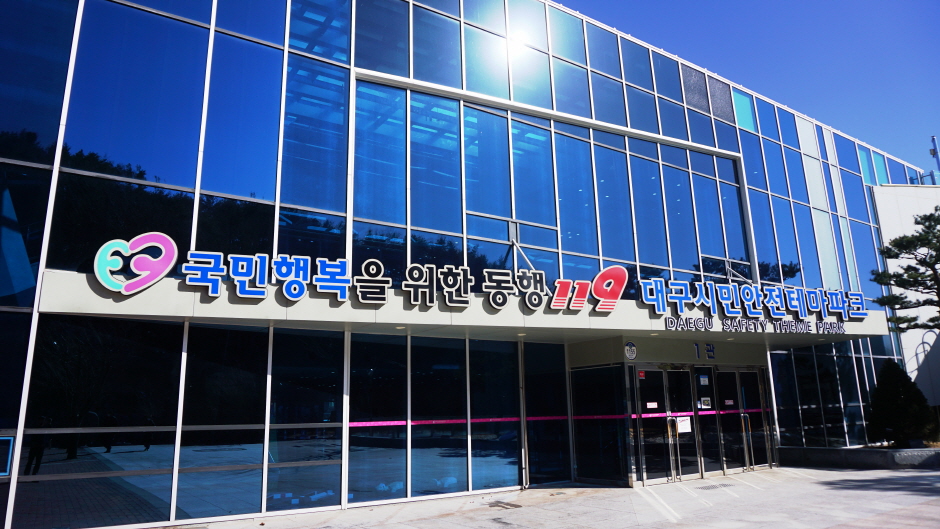

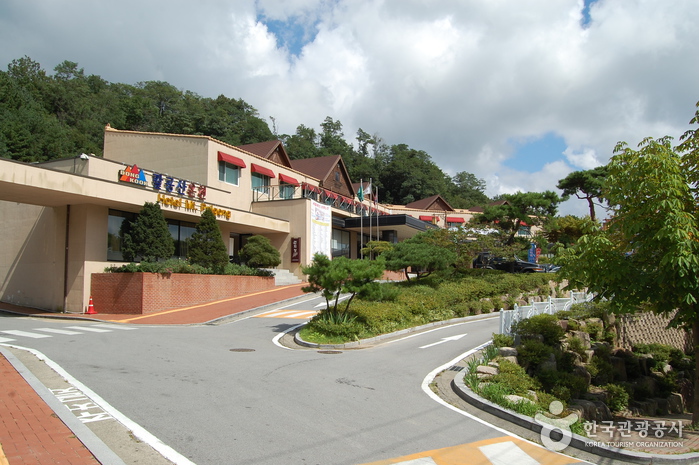
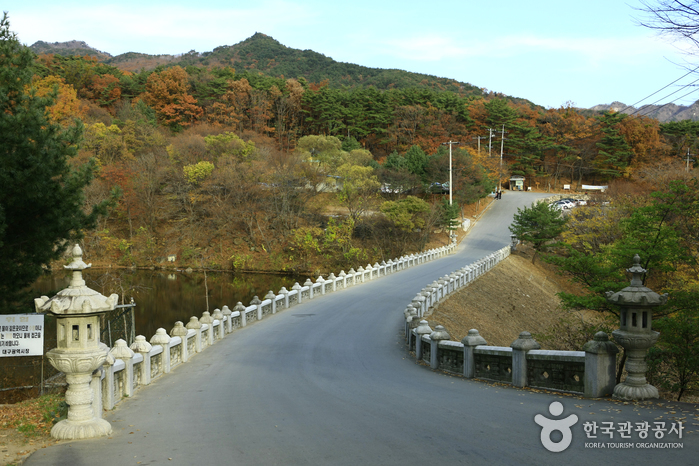
 English
English
 한국어
한국어 日本語
日本語 中文(简体)
中文(简体) Deutsch
Deutsch Français
Français Español
Español Русский
Русский